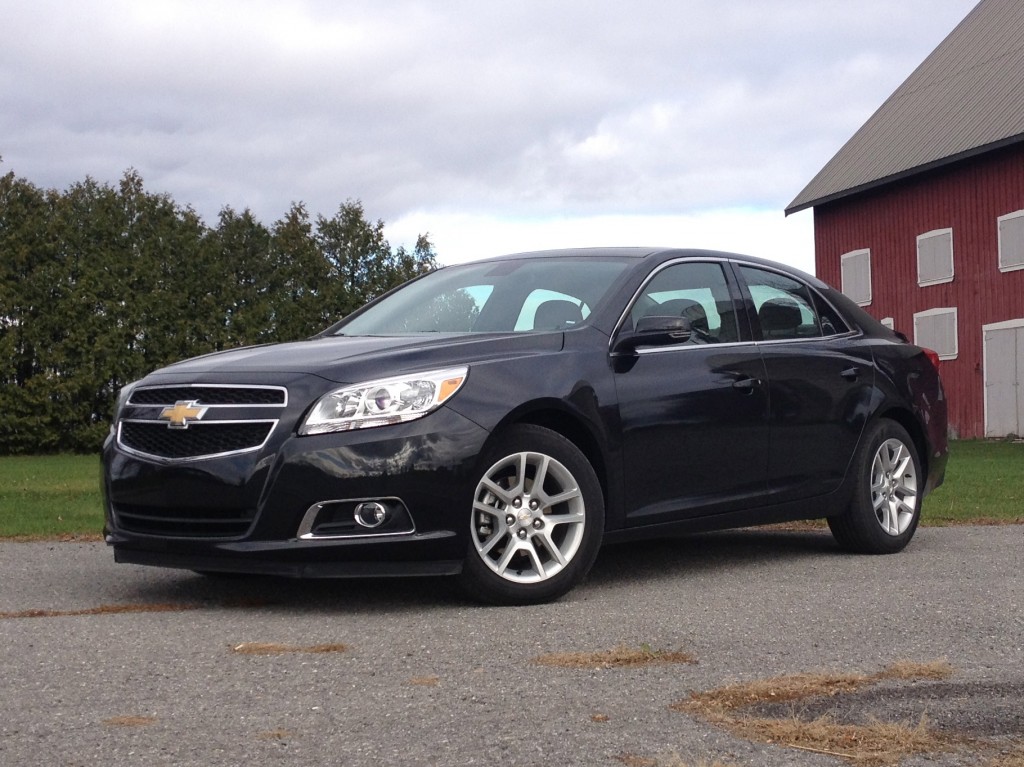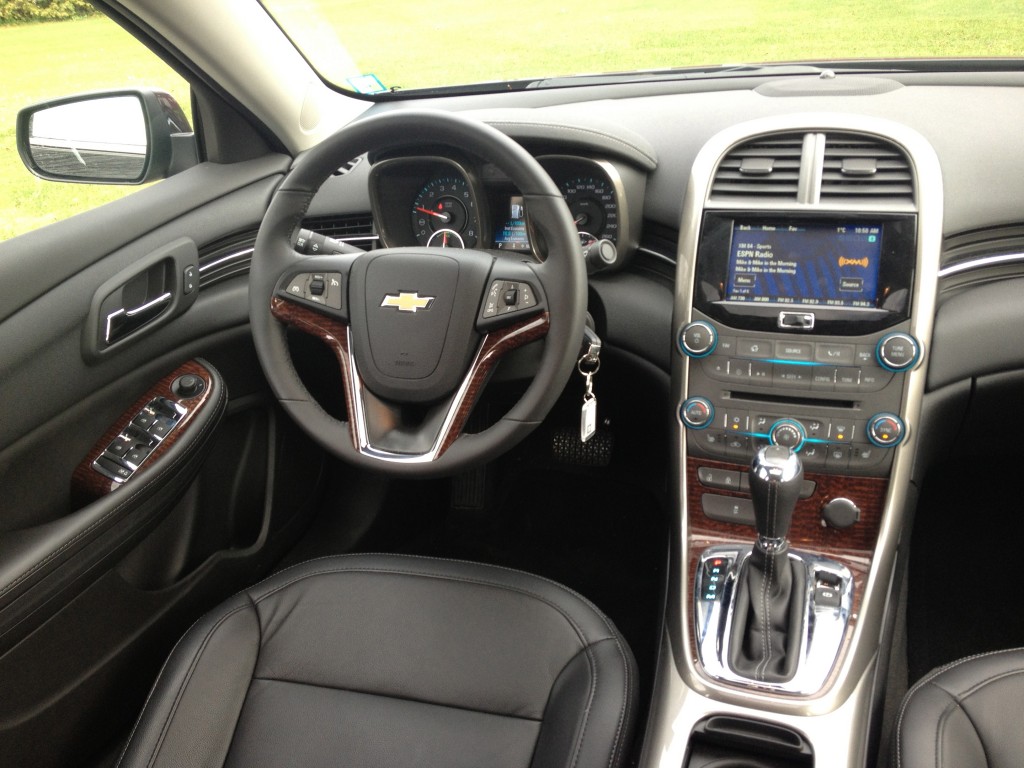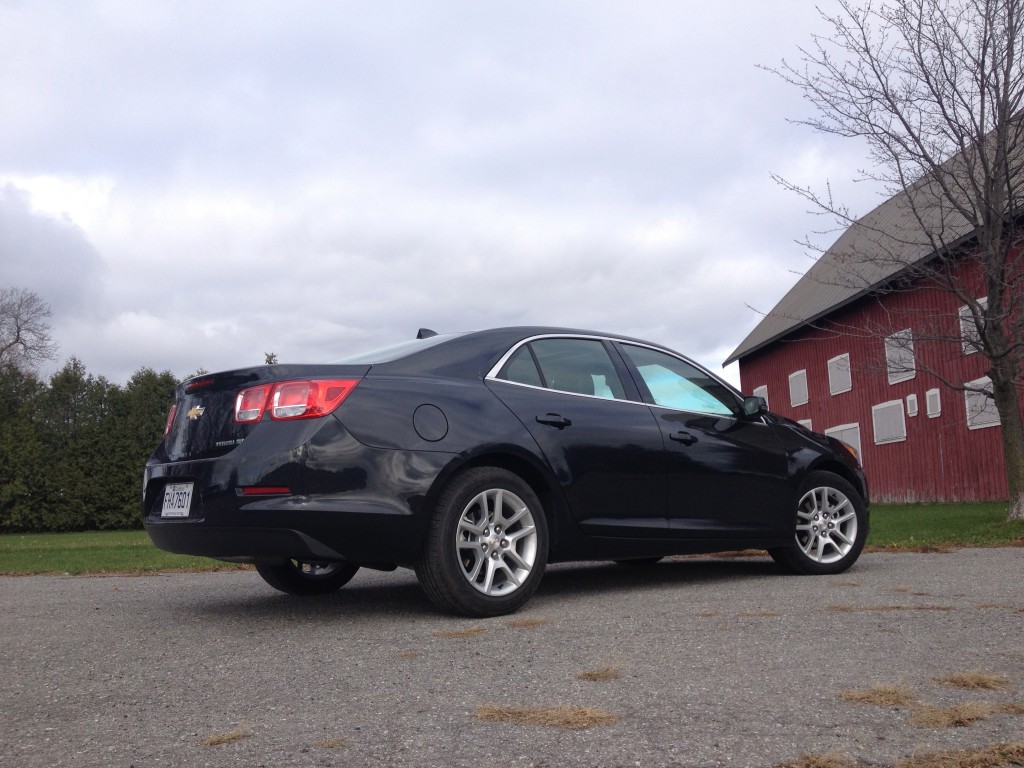Road Test: 2013 Chevrolet Malibu Eco
Story and photos by John LeBlanc
Chevrolet’s product planners must have lost the memo. The one that noted all the usual suspects in the family sedan market — Ford Fusion, Honda Accord, Mazda6, Nissan Altima and Toyota Camry — were going to be redesigned or thoroughly refreshed over the 2012 calendar year, making the class one of the most competitive ever. The “missing memo” theory is the only excuse I can come up with. Because after a week driving the new 2013 Chevrolet Malibu Eco, I’m still struggling to see how the Chevy gang could launch a “new” car that’s so, well, uncompetitive.
The $27,940 Malibu Eco costs an extra $1,615 over a base Malibu LT with its 197-horsepower 2.5-litre four-cylinder gas-only engine. The Eco uses parent General Motors’ “mild” gas-electric hybrid system, featuring a motor/generator that replaces the alternator and allows start/stop functionality. It also adds 15 horsepower to the 2.4-litre gas four-cylinder engine to deliver a combined 182 horsepower and 172 pound-feet of torque. Eco trim features also include an “active” shutter in its front grille that opens and closes depending on vehicle speed for better aerodynamics, smoother underbody panels, aluminum hood and rear bumper beam and lighter carpet and dash materials that Chevy says saves about 60 kilograms in curb weight.
The “mild” part of the Malibu Eco’s powertrain means that unlike rival hybrid family sedans like the Toyota Camry, Fusion and the Hyundai Sonata/Kia Optima twins, the Chevy cannot run on electric power alone, even for only short distances. As such, the Malibu Eco’s fuel economy is nowhere near competitive. Where the 200-hp, $27,710 Toyota Camry Hybrid is rated at 4.5 L/100 km in the city and 4.9 on the highway, the Malibu Eco scores a lacklustre 8.1 and 5.3, respectively. While that’s good enough to be the most fuel-efficient Malibu ever, it’s not that much better than the Malibu LT’s 9.2 and 5.7 estimates. And in the real world, the Camry Hybrid I tested scored a 5.8 L/100 km average, while my Malibu Eco racked up a 10.4 number.
So, when it comes to fuel economy, the “new” 2013 Malibu Eco looks like yesterday’s news. But what about the other aspects of the new Chevy family sedan? Like its redesigned interior? Or how it goes down the road? Once again, Chevy’s product planners seem to have been working in a vacuum.
My Malibu Eco came with $5,525 worth of optional leather seats (front heated), premium audio, navigation and sunroof. But that didn’t make the Chevy feel exceptional. Except for the woeful Chrysler 200/Dodge Avenger twins, it’s hard to find an interior in this segment that has less charm, functionality or quality than the Chevy’s. The Malibu’s plasti-chrome is more plastic than chrome. Its steering wheel only tilts. Its front seats are slippery, and the Chevy’s high beltline gives the impression the driver is sitting in a bathtub. And like all older GM products, the switchgear feels brittle, and some of the buttons are hidden or you need a degree in hieroglyphics to decipher them.
Families won’t be thrilled with Chevy’s new semi-hybrid family sedan. Although the 2013 Malibu is wider than the outgoing model, its wheelbase is now measurably shorter with rear passenger legroom suffering measurably. Throw in the lost space for the Eco’s trunk-mounted battery pack, and only just a small pass through instead of fold-down seats, and you’ll have to pack cleverly for family trips.
Drivers won’t be happy either. The Malibu Eco offers almost zero steering feel. Turns taken at speed result in gobs of understeer and lots of body roll. Its six-speed automatic transmission can only be shifted by a tiny, thumb-actuated button on the shifter’s side. But hey, at least the “new” version is quieter than the older Malibu. Chevy says it used acoustic-laminate windshield and front door glass, expanding-foam acoustic baffles placed in cavities throughout the body structure and plenty of sound-deadening material on the 2013 Malibu’s floor pan.
Admittedly, expectations were high for the five-passenger, four-door, front-wheel-drive 2013 Malibu. It’s built on the same platform as the Buick Regal, one of my favourite GM cars. And at a time when fuel-economy ranks high with many new car buyers, the supposedly parsimonious Eco version looks like the right car at the right time. Instead, the new Chevy family sedan seldom impresses and mainly disappoints.
Other than its quiet and comfortable highway ride — a quality not exclusive in this class — it’s hard to pick the new Malibu (Eco or not) over the majority of its rivals. And this writer isn’t alone in that opinion.
Due to slow sales, 2013 Malibu production has been curtailed at times, and GM is moving up the mid-cycle refresh of its just-released 2013 Malibu family sedan from the planned 36 months to just 18.
Apparently Chevy is finally getting the memo.
THE SPECS
Type of vehicle Front-wheel-drive mid-size sedan
Engine 2.4L DOHC four-cylinder gas engine plus electric motor
Power 182 hp
Torque 172 lb-ft
Transmission Six-speed automatic transmission
Brakes Four-wheel disc with ABS
Tires P225/55R17
Price: base/as tested: $27,940/$33,465
Destination charge $1,500
Transport Canada fuel economy L/100 km 8.1 city, 5.3 hwy, 10.4 as-tested
Standard features: Dual-zone auto climate control; cruise control; remote keyless entry; rear window defroster; power windows and mirrors; tilt steering wheel; cloth seats; Chevrolet MyLink infotainment system and OnStar; Bluetooth, USB/iPod integration; rearview camera; 17-inch alloy wheels; four-channel anti-lock brakes; full-function traction control; four-corner electronic stability control; electronic brake force distribution; brake assist system; corner brake control; panic brake assist and drag torque control; eight standard air bags, including knee air bags and full-length side curtain air bags.








![[del.icio.us]](https://www.straight-six.com/wp-content/plugins/bookmarkify/delicious.png)
![[Digg]](https://www.straight-six.com/wp-content/plugins/bookmarkify/digg.png)
![[Facebook]](https://www.straight-six.com/wp-content/plugins/bookmarkify/facebook.png)
![[Google]](https://www.straight-six.com/wp-content/plugins/bookmarkify/google.png)
![[Reddit]](https://www.straight-six.com/wp-content/plugins/bookmarkify/reddit.png)
![[StumbleUpon]](https://www.straight-six.com/wp-content/plugins/bookmarkify/stumbleupon.png)
![[Twitter]](https://www.straight-six.com/wp-content/plugins/bookmarkify/twitter.png)
![[Email]](https://www.straight-six.com/wp-content/plugins/bookmarkify/email.png)